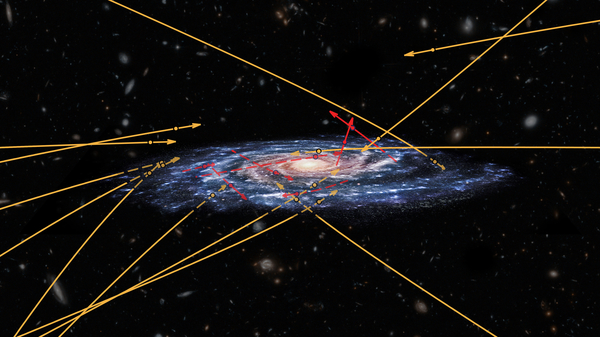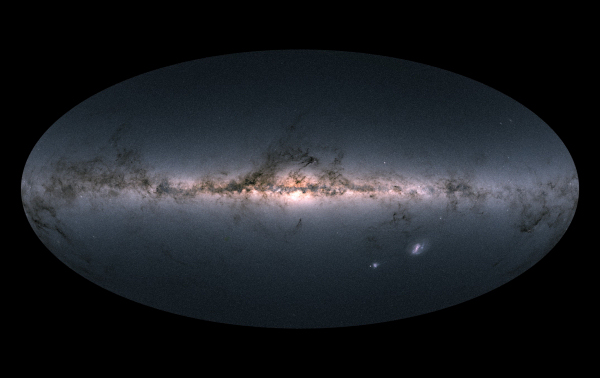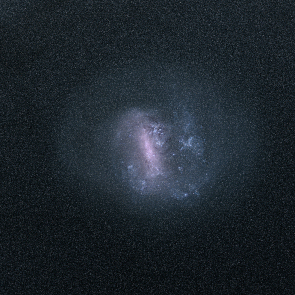Gaia spots stars flying between galaxies
2 October 2018
A team of astronomers using the latest set of data from ESA's Gaia mission to look for high-velocity stars being kicked out of the Milky Way were surprised to find stars instead sprinting inwards – perhaps from another galaxy. |
| Hypervelocity stars spotted in the Gaia data sprinting away from the Milky Way (red) and towards it (orange). Credit: ESA (artist's impression and composition); Marchetti et al. 2018 (star positions and trajectories); NASA/ESA/Hubble (background galaxies); CC BY-SA 3.0 IGO |
In April, ESA's stellar surveyor Gaia released an unprecedented catalogue of more than one billion stars. Astronomers across the world have been working ceaselessly over the past few months to explore this extraordinary dataset, scrutinising the properties and motions of stars in our Galaxy and beyond with never before achieved precision, giving rise to a multitude of new and intriguing studies.
The Milky Way contains over a hundred billion stars. Most are located in a disc with a dense, bulging centre, at the middle of which is a supermassive black hole. The rest are spread out in a much larger spherical halo.
Stars circle around the Milky Way at hundreds of kilometres per second, and their motions contain a wealth of information about the past history of the Galaxy. The fastest class of stars in our Galaxy are called hypervelocity stars, which are thought to start their life near the Galactic centre to be later flung towards the edge of the Milky Way via interactions with the black hole.
Only a small number of hypervelocity stars have ever been discovered, and Gaia's recently published second data release provides a unique opportunity to look for more of them.
Several groups of astronomers jumped into the brand-new dataset in search of hypervelocity stars immediately after the release. Among them, three scientists at Leiden University, the Netherlands, were in for a big surprise.
For 1.3 billion stars, Gaia measured positions, parallaxes – an indicator of their distance – and 2D motions on the plane of the sky. For seven million of the brightest ones, it also measured how quickly they move towards or away from us.
 |
| Gaia's sky in colour. Credit: ESA/Gaia/DPAC, CC BY-SA 3.0 IGO |
"Of the seven million Gaia stars with full 3D velocity measurements, we found twenty that could be travelling fast enough to eventually escape from the Milky Way," explains Elena Maria Rossi, one of the authors of the new study.
Elena and colleagues, who had already discovered a handful of hypervelocity stars last year in an exploratory study based on data from Gaia's first release, were pleasantly surprised, as they were hoping to find at most one star breaking loose from the Galaxy among these seven million. And there is more.
"Rather than flying away from the Galactic centre, most of the high velocity stars we spotted seem to be racing towards it," adds co-author Tommaso Marchetti.
"These could be stars from another galaxy, zooming right through the Milky Way."
 |
| Large Magellanic Cloud. Credit: ESA/Gaia/DPAC, CC BY-SA 3.0 IGO |
It is possible that these intergalactic interlopers come from the Large Magellanic Cloud, a relatively small galaxy orbiting the Milky Way, or they may originate from a galaxy even further afield. If that is the case, they carry the imprint of their site of origin, and studying them at much closer distances than their parent galaxy could provide unprecedented information on the nature of stars in another galaxy – similar in a way to studying martian material brought to our planet by meteorites.
"Stars can be accelerated to high velocities when they interact with a supermassive black hole," Elena explains.
"So the presence of these stars might be a sign of such black holes in nearby galaxies. But the stars may also have once been part of a binary system, flung towards the Milky Way when their companion star exploded as a supernova. Either way, studying them could tell us more about these kinds of processes in nearby galaxies."
An alternative explanation is that the newly identified sprinting stars could be native to our Galaxy's halo, accelerated and pushed inwards through interactions with one of the dwarf galaxies that fell towards the Milky Way during its build-up history. Additional information about the age and composition of the stars could help the astronomers clarify their origin.
"A star from the Milky Way halo is likely to be fairly old and mostly made of hydrogen, whereas stars from other galaxies could contain lots of heavier elements," says Tommaso.
"Looking at the colours of stars tells us more about what they are made of."
New data will help nail down the nature and origin of these stars with more certainty, and the team will use ground-based telescopes to find out more about them. In the meantime, Gaia continues to make observations of the full sky, including the stars analysed in this study.
While investigating the nature of these possible stellar interlopers, the team is also busy digging into the full dataset from Gaia's second release, searching for more high-speed stars and looking forward to the future. At least two more Gaia data releases are planned in the 2020s, and each will provide both more precise and new information on a larger set of stars.
"We eventually expect full 3D velocity measurements for up to 150 million stars," explains co-author Anthony Brown, chair of the Gaia Data Processing and Analysis Consortium Executive.
"This will help find hundreds or thousands of hypervelocity stars, understand their origin in much more detail, and use them to investigate the Galactic centre environment as well as the history of our Galaxy," he adds.
"This exciting result shows that Gaia is a true discovery machine, providing the ground for completely unexpected discoveries about our Galaxy," concludes Timo Prusti, Gaia project scientist at ESA.
Notes for editors
"Gaia DR2 in 6D: Searching for the fastest stars in the Galaxy" by T. Marchetti et al. is published in Monthly Notices of the Royal Astronomical Society.
For further information, please contact:
Elena Maria Rossi
Leiden Observatory, Leiden University
Leiden, The Netherlands
Tel: +31 6 8112 1440
Email: emr![]() strw.leidenuniv.nl
strw.leidenuniv.nl
Tommaso Marchetti
Leiden Observatory, Leiden University
Leiden, The Netherlands
Tel: +31 6 4776 9205
Email: marchetti![]() strw.leidenuniv.nl
strw.leidenuniv.nl
Anthony Brown
Leiden Observatory, Leiden University
Leiden, The Netherlands
Email: brown![]() strw.leidenuniv.nl
strw.leidenuniv.nl
Timo Prusti
Gaia Project Scientist
European Space Agency
Email: timo.prusti![]() esa.int
esa.int
Markus Bauer
ESA Science Communication Officer
Tel: +31 71 565 6799
Mob: +31 61 594 3 954
Email: markus.bauer![]() esa.int
esa.int



